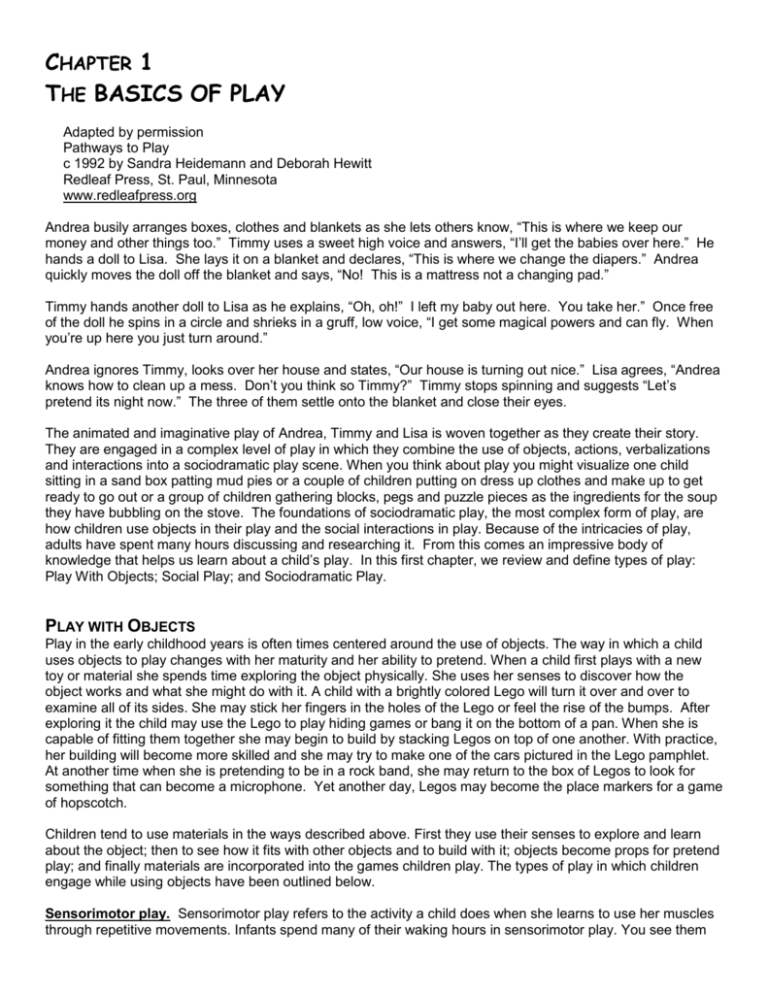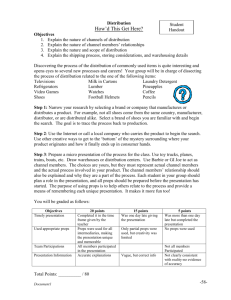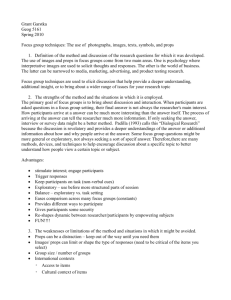the basics of play
advertisement

CHAPTER 1 THE BASICS OF PLAY Adapted by permission Pathways to Play c 1992 by Sandra Heidemann and Deborah Hewitt Redleaf Press, St. Paul, Minnesota www.redleafpress.org Andrea busily arranges boxes, clothes and blankets as she lets others know, “This is where we keep our money and other things too.” Timmy uses a sweet high voice and answers, “I’ll get the babies over here.” He hands a doll to Lisa. She lays it on a blanket and declares, “This is where we change the diapers.” Andrea quickly moves the doll off the blanket and says, “No! This is a mattress not a changing pad.” Timmy hands another doll to Lisa as he explains, “Oh, oh!” I left my baby out here. You take her.” Once free of the doll he spins in a circle and shrieks in a gruff, low voice, “I get some magical powers and can fly. When you’re up here you just turn around.” Andrea ignores Timmy, looks over her house and states, “Our house is turning out nice.” Lisa agrees, “Andrea knows how to clean up a mess. Don’t you think so Timmy?” Timmy stops spinning and suggests “Let’s pretend its night now.” The three of them settle onto the blanket and close their eyes. The animated and imaginative play of Andrea, Timmy and Lisa is woven together as they create their story. They are engaged in a complex level of play in which they combine the use of objects, actions, verbalizations and interactions into a sociodramatic play scene. When you think about play you might visualize one child sitting in a sand box patting mud pies or a couple of children putting on dress up clothes and make up to get ready to go out or a group of children gathering blocks, pegs and puzzle pieces as the ingredients for the soup they have bubbling on the stove. The foundations of sociodramatic play, the most complex form of play, are how children use objects in their play and the social interactions in play. Because of the intricacies of play, adults have spent many hours discussing and researching it. From this comes an impressive body of knowledge that helps us learn about a child’s play. In this first chapter, we review and define types of play: Play With Objects; Social Play; and Sociodramatic Play. PLAY WITH OBJECTS Play in the early childhood years is often times centered around the use of objects. The way in which a child uses objects to play changes with her maturity and her ability to pretend. When a child first plays with a new toy or material she spends time exploring the object physically. She uses her senses to discover how the object works and what she might do with it. A child with a brightly colored Lego will turn it over and over to examine all of its sides. She may stick her fingers in the holes of the Lego or feel the rise of the bumps. After exploring it the child may use the Lego to play hiding games or bang it on the bottom of a pan. When she is capable of fitting them together she may begin to build by stacking Legos on top of one another. With practice, her building will become more skilled and she may try to make one of the cars pictured in the Lego pamphlet. At another time when she is pretending to be in a rock band, she may return to the box of Legos to look for something that can become a microphone. Yet another day, Legos may become the place markers for a game of hopscotch. Children tend to use materials in the ways described above. First they use their senses to explore and learn about the object; then to see how it fits with other objects and to build with it; objects become props for pretend play; and finally materials are incorporated into the games children play. The types of play in which children engage while using objects have been outlined below. Sensorimotor play. Sensorimotor play refers to the activity a child does when she learns to use her muscles through repetitive movements. Infants spend many of their waking hours in sensorimotor play. You see them explore objects by turning them, pressing, poking, and prodding. Toddlers demonstrate their sensorimotor skills when they dump toys or practice jumping. Preschoolers engage in this form of play when stirring sand, patting playdough, or pouring water. Constructive play. Hunter, a 5 year old boy, took several chunks of playdough the size of robin’s eggs and began rolling them into balls. He asked for toothpicks which he stuck into the balls at various places. Finally, he connected the balls with drinking straws and announced he had built the “borf molecule.” Hunter is engaged in constructive play. Here he uses materials to make or build things. Construction may begin at a very simple level when a 12 month old learns to place one block on top of another. You might see a toddler stack ten blocks in a tower. As the child’s skills improve she may show her ability to balance her design and use materials to duplicate a building or a molecule as Hunter had. Other materials like Tinker Toys, Legos, playdough, and markers might be used by a child to construct. Dramatic play. Dramatic play involves two skills: (A) representational skills, when a child begins to use objects to pretend, and (B) role playing, when the child takes on a pretend role. A.) REPRESENTATIONAL SKILLS The ability to have one item represent another, referred to as a representational skill, is closely related to the child’s cognitive development (Vygotsky, 1976) (Golomb, 1979). As a child matures she is able to think more abstractly (Piaget, 1962). A symbol or a replica of an object can take the place of the real object in the child’s mind. The ways in which a child uses objects to represent others corresponds to this cognitive maturation (Wolfgang, Mackender and Wolfgang, 1981). Young children need to use a real object or an exact replica of the object in their play. For instance, in pretending to diaper a doll an 18 month old child would do best using a real diaper. Shortly after a child turns 2 she may be able to use a substitute or a similar object to pretend. A replica of a diaper such as a Cabbage Patch diaper might be used by a child at this level. When a child is around 3 years of age materials further from the real object might be substituted in play. In the diapering example, a child at this level may use a Kleenex as a diaper. At 4 years a child may be capable of pretending to diaper with no diaper at all. This demonstrates that she is able to think more abstractly than before since she is now able to let her actions take the place of a real object. B) ROLE PLAYING Role playing is also an important part of dramatic play. Children role play when they use materials, voice and actions to imitate others during play (Wolfgang, Mackender and Wolfgang, 1981). When a child first learns to role play she takes on familiar roles such as a parent or a doctor. She uses the materials they would as props to support her actions as she plays. For instance, she may use a cylinder block as a shot when pretending to be a doctor. As she becomes familiar with other people and their roles she may imitate the actions and verbalizations of a grocer, waitress, or firefighter. Playing fantasy characters such as monster, Cinderella, or a super hero are common as a child is able to engage in more abstract thinking. Games with rules. Children play games with rules at all ages. The games and rules change as the child grows older. Infants play games like peek a boo or drop the toy off the high chair tray. Toddlers enjoy games of chase and preschoolers begin to do well with simple board games. At whatever age, games have rules that are agreed upon by all players. Rules help to organize play and allow it to continue. Play is more or less cooperative between a pair of players or within a group of children. Sometimes the rules are established prior to the game as they might be in a board game. Simple games with rules with which you are familiar include pat a cake, lotto, and tag. More complicated games with rules are Candyland, Chutes and Ladders, and Dodge Ball. In all games if the rules are not agreed upon and followed by all the players it quickly becomes a source of conflict and play may fall apart. The many ways children use materials in play is a vital part of understanding their play. The types of play with objects have been summarized on the following chart. PLAY WITH OBJECTS TYPE OF PLAY Sensorimotor Constructive Dramatic Games with rules USE OF OBJECT Explores properties of object by banging, stirring, rolling, etc. Uses materials to make or build things Uses objects to pretend Begins with real objects Acts out roles using imaginary objects Games are played with rules that are shared. Rules can be unspoken or formally stated EXAMPLES Banging pots and pans Making mud pies Blocks Legos Bristle Blocks Playing house, restaurant, or doctor Peek-a-boo Chase Chutes and Ladders Candyland Adapted from McNellis, Ed., 1987. SOCIAL PLAY As children play they come into contact with other children as well as with objects. Playing with others requires that children learn to coordinate their behaviors in order for the play to continue in a cooperative manner. Children must learn the give and take patterns of social play. Five generally accepted, characteristics of social play are helpful to review as we examine interaction patterns (Parten, 1932). Social Play Play with Adults Solitary Play Parallel Play Associative Play Cooperative Play Types of Play Plays with parent or other adult Plays alone rather than with peers Children play side by side. Activities are unrelated Children play with same materials but without creating together Children create a play them together Adapted from McNellis, Ed. 1987. Age that this Begins Birth 12 – 18 months 2 – 2.5 years 2.5 – 3 years 3 – 3.5 years Play with adults. Play with others usually begins with adult/child interactions. Very young infants will play games of sorts with their parents as they coo back and forth to one another. Or the adult may begin an interaction by blowing a bubble and pausing for a response. The child laughs or blows a bubble back and the game starts over again. The interactions are usually repetitious as this example suggests. This rhythmic interaction between the adult and child helps to establish a conversational tone and is viewed by some as the beginnings of turn-taking (Mac Donald and Gillette, 1985). Other examples of typical play between infants and adults include peek a boo, “so big” and pat a cake. Solitary Play. Jose brought his caregiver blocks to stack. He watched expectantly as the tower grew taller and taller. After about 10 blocks were stacked he could stand it no longer and gleefully kicked them over. Gabriel was nearby. He picked up snap together beads and put them in a carton. He glanced frequently in Jose’s direction but did not attempt to join his play. This type of solitary play is what you see when watching a 12 to 18 month old. Children this age usually play alone rather than with their peers. The presence of an adult is quite important in order to ensure the continuation of play. Children gain approval and a sense of security from the adult’s presence, their attention, and comments. Children at this age will watch and enjoy the activity of others. However, they have not yet learned to coordinate their behaviors so that they are able to play together. When infants do interact, the interaction is usually very brief and most often it comes about because both children want the same toy at the same time (Rubin, 1980). Infants may also interact with one another by touching, poking or prodding. Usually the child is trying to learn about this other creature in the same physically explorative way they learn about the rest of the world around them (Rubin,1980). You need a watchful eye at these times as the exploration can all too quickly become hair pulling or pinching. Parallel Play. Between the ages of two and two and a half play changes and you begin to see children play nearer to one another. Parallel play is characterized by the way the children play side by side but with very little exchange of materials or conversation. At this level, the activities of the children are likely to be unrelated. For instance, while sitting next to one another one child may be talking on a toy telephone while another, is building with blocks. You might also see parallel play where a number of children are playing in the housekeeping corner and even though they are all pretending to cook, they are not exchanging any ideas or conversation. Children engaging in parallel play like being near each other but are not ready for much exchange. Associative Play. A group of children were seated at a table and were all using playdough. Ernie rolled ropes, Theresa used the rolling pin to flatten out pancakes while Destry patted the dough until it was flat enough to use a cookie cutter. When Theresa saw Ernie use a scissor to cut his rope into pretend pieces of candy, she abandoned her rolling pin and began to roll ropes too. A few minutes later she searched for a scissors and cut her ropes in small pieces. These children are engaging in associative play. At two and a half or three, children begin to like playing in groups that are involved in the same activity. The children tend to watch one another and to imitate the actions of their peers but verbal exchanges are limited. They borrow materials and ideas from one another but they do not work together in order to create. A child might look over to see what her neighbor is building and before long she will build the same thing. Their buildings however, remain separate. Cooperative Play. Cooperative play begins with the simple back and forth play of two children. They attempt to coordinate their actions so that they are able to roll a ball back and forth or take turns talking on a toy telephone. In these early interchanges they practice with a peer the turn taking pattern of “first me, then you.” In their preschool years, they develop their interaction skills further and some group play begins to form. They learn to play together deciding what they will play and what role they will take. In cooperative play all the children involved take part in the same activity. They may pretend to take a trip to the library by setting up a scene with a librarian, people reading books and the computer system to check out books. Their conversation may sound something like this: Joe: “I’m going to be the librarian so I’ll go get the books. You be the customer and come to my check out.” Sam: “I’ve got all these books here. I want to take them home. Joe: “No, you can only take a few of them, not all. Where is your library card? You got to have a card. Here you can use this for your card.” SOCIODRAMTIC PLAY When we study play we tend to divide play with objects from play with people. But when we observe play as it takes place we see how related these two are. The skills needed to manipulate and pretend with objects in dramatic play as well as the social skills in cooperative play are both needed. The two types of play overlap when we see groups of children work together to construct a building or we view children pretending to be childcare providers. Sociodramatic play is the term used to describe how these two types of play come together. Sociodramatic is recognized as the highest level of dramatic play (Christie, 1982) because it requires the combination of social and dramatic play skills. Sara Smilansky (1968) describes 6 elements of play which must be present in order for play to be considered sociodramatic. The elements are listed below. 1. Imitative role play 2. 3. 4. 5. 6. Make-believe in regard to objects Make-believe in regard to actions and situations Interaction Verbal communication Persistence Adapted from Smilansky, 1968 Sociodramatic play prepares a child for many of life’s experiences. The representational skills practiced in sociodramatic play are essential to the child’s ability to conceptualize many of the things taught in school. Reading deals with symbols for language, numerical symbols represent objects and science uses molecules to stand for the unseen. The interactions of a child in play prepares her for the give and take of social relationships. Creativity is strengthened as a child develops a variety of ways to solve dilemmas that arise or as she learns to creatively expand on situations she has observed and plays them in new ways (Smilansky, 1968,1990). Competent sociodramatic players have mastered the necessary skills of creativity, representation and interaction. Many preschoolers will learn the skills needed for sociodramatic play by watching others and by playing in groups. However, not all children are able to put dramatic and social skills in sociodramatic play together through exposure to group play sessions alone. For these children, the techniques described in this book are needed to help them learn to play at this highly developed level. CHAPTER 2 SETTING THE STAGE Adapted by permission Pathways to Play c 1992 by Sandra Heidemann and Deborah Hewitt Redleaf Press, St. Paul, Minnesota www.redleafpress.org Amy, Mike and Darius are playing “fighting fires” by the climber. They have created houses with the large blocks. Amy shouts excitedly, “Oh, no! Our house is on fire!” The teacher had put out a long rubber hose and the three children are excitedly aiming the hose at the blocks. Amy says, “Oh, I think the fire is almost out.” Mike yells, “Oh no, that one over there is on fire!” They quickly pull the hose to the climber. Darius leaves the group to put a block down and he beckons, “Come on, let’s go in our fire truck now to the station.” The climber becomes the station and the play goes on much to the enjoyment of all. Scenes like the scene above are witnessed over and over again in schools and homes. The play looks effortless and goes so smoothly that the caregiver may appreciate the children’s enthusiasm and go on to more pressing tasks. Before Amy, Mike and Darius began playing the caregiver did several things that contributed to the success of this play. The things done to set the stage by adults determine how much play children do as well as the quality of the play. In this chapter, we discuss what things adults can do to influence the quantity and quality of play. The four main factors are: Time Space Props Planned Experiences The definitions of play in Chapter 1 emphasized the complexity of play. In the course of growing up, most children acquire play skills easily and naturally. However, adults can provide supports that increase the likelihood that children will succeed in their play together. In the example at the beginning of this chapter, the caregiver had ensured that equipment like the hose and climber were available to Amy, Mike and Darius. She had also provided enough time so that play would develop. The adult assistance in the play was not immediately obvious to an observer. When play is going smoothly, these stage setting tasks are the kinds of supports children need. Researchers have documented that adults can encourage high quality play in the four following ways: 1. 2. 3. 4. Providing an adequate amount of free choice time Designing space that invites play Providing a large variety of props Providing planned experiences that are related to play Adapted from Johnson, Christie, & Yawkey, 1987 TIME It is vital that children have enough time to plan and carry out sociodramatic play. It often takes awhile just to set up the play, chose the roles, work out conflicts and get other children involved. It is recommended that free play periods should last from 30 to 50 minutes each (Johnson, Christie, & Yawkey, 1987). If play periods are shorter than this, children may choose simpler forms of play (Johnson, Christie, & Yawkey, 1987). In our example at the beginning of the chapter, the teacher had provided a 45 minute free play time. The exciting firefighting didn’t occur until 30 minutes into that time. SPACE Planning an appropriate space for play to happen is one of the biggest influences an adult can have in children’s play. An environment that is well-planned draws children in. An environment that is haphazard and too open can actually increase aggression and disruption. Following are some considerations for planning a space for play: • Arrange the room so children can see the toys and materials as they enter the room. • Include play areas that encourage solitary, parallel and sociodramatic play. Both block and • • • • • • housekeeping areas encourage more social play. Housekeeping play results in more language than other areas. Puzzles encourage more solitary play. Plan play experiences outdoors as well as indoors. Studies have shown that boys and children from low income homes actually play longer and with more complexity outdoors. Include both a house and block area in your space. Create an opening between the housekeeping area and block area so that materials can be used together or moved back and forth. This can result in more boy-girl play and use of blocks as props by older children. Occasionally use a separate room for a play theme if possible. This heightens interest and excitement. When adding separate dramatic play themes to your setting, such as a post office, fire station, or a doctor’s office, keep the house corner as well. Such arrangements lengthen the time children play together because children have more options to explore. As they expand their play, they use the house corner as a base for their activity. Set up learning centers that are well-defined, enclosed and visible. Well-defined spaces increase the amount of play more than wide-open spaces. Include a variety of materials in the play areas that you set up. Following is a chart that outlines possible play areas and materials. (Johnson, Christie, & Yawkey, 1987) Play Areas AREAS Art Activities House Manipulative Blocks Science Large Motor Sensorimotor Reading Corner MATERIALS Pencils, crayons, markers, scissors, paper, shape insets, rulers Stove, refrigerator, table, dishes, play food, pots and pans, cupboards, dress-up clothes, cradle, dolls, doll clothes, telephone Legos, games, bristle blocks, popoids, puzzles Unit blocks, large blocks, cars and trucks, animals, other props for blocks Rocks, feathers, shells, fish, or animals, scale, leaves, wood Slide, climber, rebounder, form blocks, boxes, waffle blocks, tunnel Sand, water, beans, cornmeal Books, puppets, record player or cassette player, flannel board PROPS Props are an essential part of a child’s play. Any toy or material that a child uses to play is called a prop. Blocks, dress up clothes, playdough, and Legos are all examples of props. Caregivers need to provide a large variety of props to encourage the types of play discussed in Chapter l. Caregivers have observed for many years that children’s play changes according to the play materials available (Johnson, Christie, & Yawkey, 1987). For instance, costumes or other theme related props will encourage more sociodramatic play than puzzles or play dough. Children playing with puzzles often engage in solitary play. Thus, caregivers should survey their environment to ensure that many types of props are available. This provides children with many options during free choice time. The chart below outlines the types of play and the toys or materials associated with it. With this chart, you can observe children’s choices in play materials and identify which types of play individual children prefer. By expanding their choices, the children will gain more experience in other types of play. Types of Play Associated with Play Materials Social Play Parallel & Solitary Cooperative Blocks Housekeeping toys Puzzles Dolls Beads Dress up clothes Art Materials Vehicles Clay and playdough Blocks Sand and water Legos and other manipulatives Legos and other manipulatives Play with Objects Sensorimotor Constructive Dramatic Beads Blocks Housekeeping toys Clay and playdough Puzzles Dolls Sand and water Art Materials Dress up clothes Legos and other manipulatives Legos and other manipulatives Vehicles Adapted from Johnson, Christie, & Yawkey, 1987 Besides providing many types of props, caregivers should include a mixture of realistic and more unstructured materials in the classroom. For instance, a house corner could have a cradle, stove, and refrigerator that look real. Pretend vegetables, steak, and potatoes could be used in pots and pans. However, some unstructured materials like cardboard boxes, scraps of materials and paper could be used for any number of play themes. Younger children, ages 2, 3 and 4 will need more real objects to maintain pretend themes. Older children ages 4, 5 and 6. will feel comfortable incorporating cardboard boxes, featureless dolls and blocks as well as real objects in their play. Special needs children with cognitive, language, and behavioral delays may need real objects for a longer time to encourage pretend play. Caregivers should look at the ages and skills of the children in their care to determine how many props should be realistic. Caregivers should provide enough props so that children are not always competing for toys. This can help to cut down the number of fights and conflicts between children. There are some props that must be shared because caregivers cannot afford to buy one for each child. No child care center or home could provide a trike for every child that wants one. But some props do not involve as much expense. Caregivers can provide more of these toys. For example, one teacher saw that the three year old children were constantly fighting over the plastic phones. She thought about several options to solve the problem and discussed them with her supervisor. Most of the solutions focused on teaching the children to share. The supervisor suggested, “Why don’t you buy 3 more phones?” The teacher decided to try that. Once the extra phones were bought and added to the environment, the fighting over the phones virtually stopped. When you are deciding how many of a certain toy to include in your play space, look at the ages of the children in your group. Younger children need more of each type of popular toys because they have less ability to share. We have one final word about props. The props you include in your environment should reflect the cultures of the children in your care. Talk to the parents about what special things they do at home and include these activities in the children’s play props. Invite parents in to share cultural interests. By doing this you encourage more play, give a sense of inclusion to all children in your setting, and teach respect for differences. Expand the children’s awareness and understanding of other ethnic and racial backgrounds. Survey your environment to ensure the toys and materials reflect diversity of experience, race and culture. For example, puzzles, books, dolls, and pictures should reflect diversity and the value you place on that (Derman-Sparks, 1989). PLANNED EXPERIENCES Children may need more experience to act out roles in sociodramatic play. All children have some idea of roles within a household. However, work related roles may be difficult for them to act out unless they have observed them. This means that adults need to give the children additional experience when introducing a new play theme. These experiences can include field trips, classroom visitations by people in different occupations and books and videos about different jobs (Johnson, Christie, & Yawkey, 1987). The teacher in our first example had taken her class to the fire station the week before. The children were able to get on the truck and see much of the equipment. Later they could act out fighting a fire using props that represented this equipment. Little did Amy, Mike and Darius know as they became engrossed in fighting the fire that the teacher had done a great amount of behind the scenes work. She had set the stage for play by attending to how much time she allowed for play, how she arranged the space, what props she included in her environment, and what kinds of experiences she planned. Provide these same supports and most children will acquire the play skills they need. After you have done this, watch the children’s play. You will learn how the whole group interacts, how your space and props work and which individual children need more help to become involved with the others.






